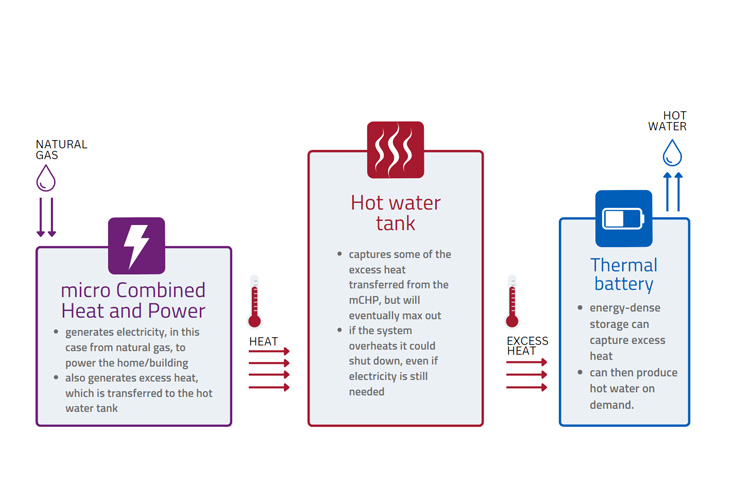“These batteries come in all different sizes, but the one we’re looking at is primarily for a residential home and it’s meant to replace a hot water tank,” says Willson, Principal Investigator, Smart Building Management with SAIT’s Applied Research and Innovation Services (ARIS).
Unlike a hot water tank, the battery contains a more energy-dense material. This phase-change material allows increased excess heat to be captured in the appliance with a much smaller form factor. Hot water is not stored in the battery — instead, energy is transferred to cold water, through a phase change in the material. It releases the stored thermal energy to heat the water, operating essentially as hot water on demand.
The integrated thermal battery system

Just add heat — and a little research
The team testing this application have all studied at SAIT.
Willson is a graduate of the SAIT Information Technology program, and Julio Jacome de Paz, Project Coordinator, graduated from the Mechanical Engineering Technology program. Maeric Rico, the student working on software to analyze the data from the flow and temperature sensors, studied Computer Science and graduated from the Civil Engineering Technology program.
ARIS has partnered with Home Completions on the project. Additionally, as part of bringing energy solutions to the province, this project received funding from Alberta Innovates through the Campus Alberta Small Business Engagement program and Natural Sciences and Engineering Research Council funding through the Applied Research and Development for Colleges program. The mCHP was donated from ATCO as part of a previous research project and continues to be used in cold weather climate research today.
“Through this project, we’re aiming to get data by testing this unique systems integration. The results may also be useful in applications such as powering off-grid buildings, better use of solar photovoltaic energy, more effective use of mechanical systems or in commercial electric vehicles to maintain a consistent heat, even in winter,” says Willson.
The team is evaluating the performance of the mCHP and the thermal battery as one system to determine the most efficient way to store the thermal energy released during the power generation process, and to be used later as hot water on demand, primarily in residential homes. The key to a more sustainable energy system is the commercially available thermal battery.
The second potential outcome is improved reliability of the mCHP when operated as part of this system.
“One of the downfalls from our past research of mCHPs is, when you’re running the generator to produce power for your building, it also has to produce heat and that heat has to go somewhere,” says Willson.
When the mCHP overheats, it turns off, regardless of whether you still need electricity. The integration of the thermal battery will provide another larger outlet for the excess heat.
“You can use wasted heat for other things, in this case the hot water tank and the thermal battery in a home or building, but the applications are anywhere that you would want to generate power on site,” says Willson.
Combining heat and power for efficiencies is an old idea, but as more energy dense material is developed, new applications are tested and power demand is better understood, there’s more opportunity to increase the efficiency of our energy use and its sustainability. This is the type of innovation and applied research ARIS continues to investigate as part of its commitment to building integrated renewable energy. Read more about ARIS’ recent projects and learn more about how we work with industry partners to find applied research solutions as one of Canada’s top applied research colleges.